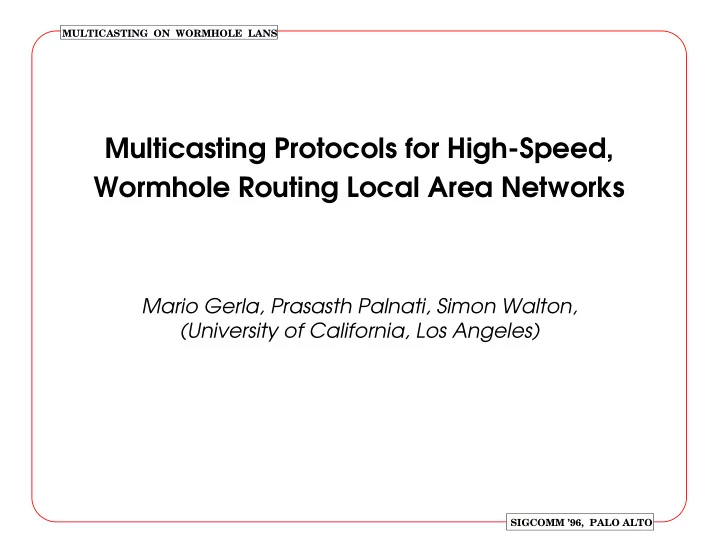

MULTICASTING ON WORMHOLE LANS Multicasting Protocols for High-Speed, Wormhole Routing Local Area Networks Mario Gerla, Prasasth Palnati, Simon Walton, (University of California, Los Angeles) SIGCOMM ’96, PALO ALTO
THE SUPERCOMPUTER SUPERNET University of California at Los Angeles, Jet Propulsion Laboratory, Aerospace Corporation key W/S W/S = workstation W/S OPTIMIC W/S Myrinet W/S other Myrinet switch W/S Computer Science Myrinet Dept switch W/S Supercomputer Myrinet OCI (SP1) switch Electronic Engineering Dept Myrinet optical W/S switch star W/S Myrinet OCI switch OCI W/S W/S ATM Myrinet switch W/S HIPPI IF OCI OCI 800 Mb/s JPL W/S Supercomputer OCI Myrinet Myrinet (Delta) switch switch W/S W/S W/S Caltech Myrinet switch Aerospace W/S Corp
MULTICASTING ON WORMHOLE LANS Wormhole Routing Wormhole routing employs cut-through and link-by-link flow-control The Myrinet wormhole LAN employs source routing – the packet destination address is a sequence of switch port numbers Backpressure propagated SIGCOMM ’96, PALO ALTO
MULTICASTING ON WORMHOLE LANS Deadlock in Wormhole Networks Deadlock in wormhole networks can occur when cycles of contention for switch output ports arise This is prevented in the case of Myrinet by the use of a restricted routing scheme known as up/down routing. SIGCOMM ’96, PALO ALTO
MULTICASTING ON WORMHOLE LANS Multicasting within the Network Fabric It is possible to extend cut-through routing in the Deadlock! switch to achieve multicast at the switch level. The multicast worm defines a tree through the switch mesh. Backpressure applied to any outgoing branch must be propagated back. Difficulties include increased complexity of source route encoding and possibility of deadlock amongst different branches of same worm. SIGCOMM ’96, PALO ALTO
MULTICASTING ON WORMHOLE LANS multicast worm Need to encode multicast tree 1 3 as linear list for source routing 2 P 5 E 4 P 1 E 7 E Use leftmost, depth-first traversal 2 5 7 4 ‘P’ is pointer, encoded as byte offset 1 E ‘E’ is end marker 1 Encoded source route: 1 P 2 P 5 E 3 P 4 P 1 E 7 E SIGCOMM ’96, PALO ALTO
MULTICASTING ON WORMHOLE LANS Multicasting by Host Forwarding – path of multicast packet – host Use multiple host forwarding to achieve multicasting Various schemes shown above – forwarding from source host, forwarding around Hamiltonian cycle, forwarding down binary tree Worm may be stored and forwarded or cut-through SIGCOMM ’96, PALO ALTO
MULTICASTING ON WORMHOLE LANS Deadlock Prevention with Buffer Reservation Deadlock Worm forwarding can reintroduce deadlock Use buffer reservation protocol at each hop to prevent deadlock Host within switch fabric. Multicast worm NACK Each host has buffer for largest multicast worm-size. Can reduce latency with ‘optimistic’ reservation protocol – worm transmitted immediately; NACK returned by next hop Buffer full if buffer space not available SIGCOMM ’96, PALO ALTO
MULTICASTING ON WORMHOLE LANS Deadlock Prevention by Buffer Reservation 0 Buffer reservations to prevent 1 network deadlock 7 2 6 Two buffer classes used to prevent buffer reservation 3 5 deadlock 4 Host buffers are divided into two classes SIGCOMM ’96, PALO ALTO
MULTICASTING ON WORMHOLE LANS Simulation Results for Host Multicasting 9000 8000 Simulations performed using 7000 Maisie simulator at byte level. 6000 Latency, byte times 5000 Network modelled: 8x8 torus; A B 4000 10 multicast groups, each with 3000 C 10 members; offered load is 2000 1000 fraction of link speed per host. 0 0.04 0.05 0.06 0.07 0.08 0.09 0.1 0.11 0.12 Mixed multicast and unicast Offered load by each host traffic. A – multicast around cycle, store and forward B – multicast around cycle, cut-through at host C – multicast over binary tree SIGCOMM ’96, PALO ALTO
MULTICASTING ON WORMHOLE LANS Implementation of Multicasting in Myrinet 140 Single sender All send/receive 120 LANai 100 HOST Throughput, Mbit/s 80 SBus 60 Network Host Adapter 40 20 0 1000 2000 3000 4000 5000 6000 7000 8000 Packet size, bytes Hamiltonian circuit multicast scheme implemented Worm forwarding done in host adapter Experimental results show that host adapter is bottleneck SIGCOMM ’96, PALO ALTO
MULTICASTING ON WORMHOLE LANS Conclusions/Further Work Switch-fabric based solutions have the lowest latency, but impose a high degree of complexity upon the switches Multicasting based on host-forwarding is more amenable to implementation – main issue is deadlock prevention without degradation of performance Work in progress on evaluation by simulation of buffer deadlock prevention schemes SIGCOMM ’96, PALO ALTO
MULTICASTING ON WORMHOLE LANS Contact Points gerla@cs.ucla.edu Mario Gerla palnati@alpo.casc.com Prasasth Palnati simonw@cs.ucla.edu Simon Walton Supercomputer Scalable Network http://millennium.cs.ucla.edu/~ssn Computer Science Dept., UCLA http://www.cs.ucla.edu SIGCOMM ’96, PALO ALTO
Recommend
More recommend